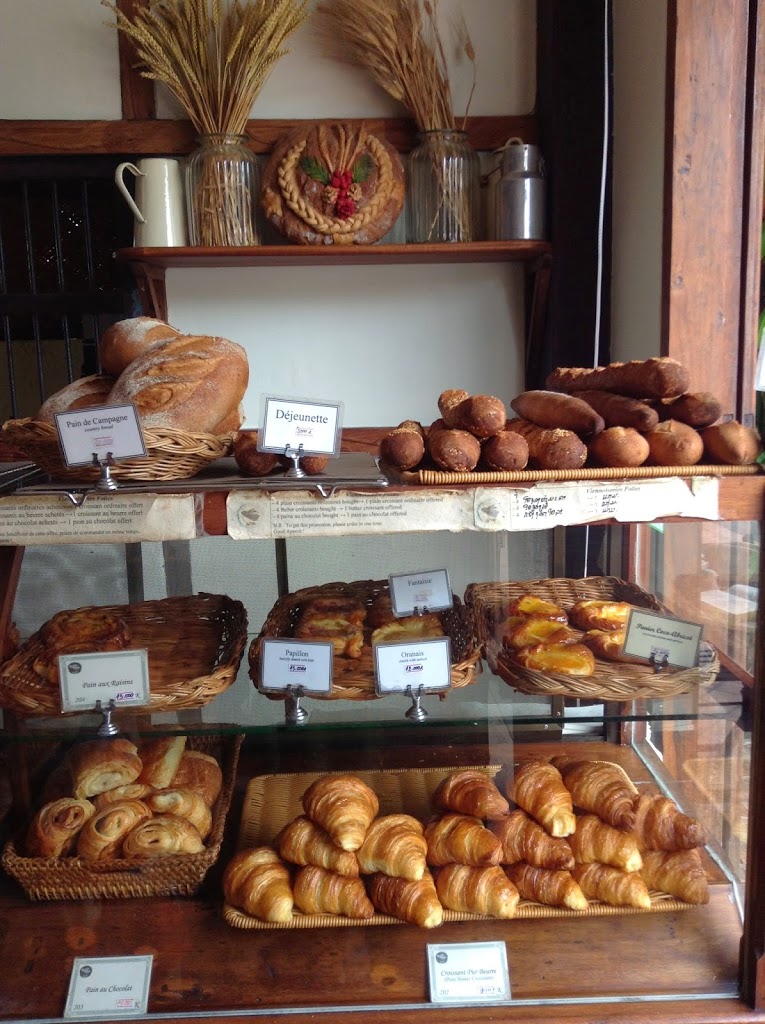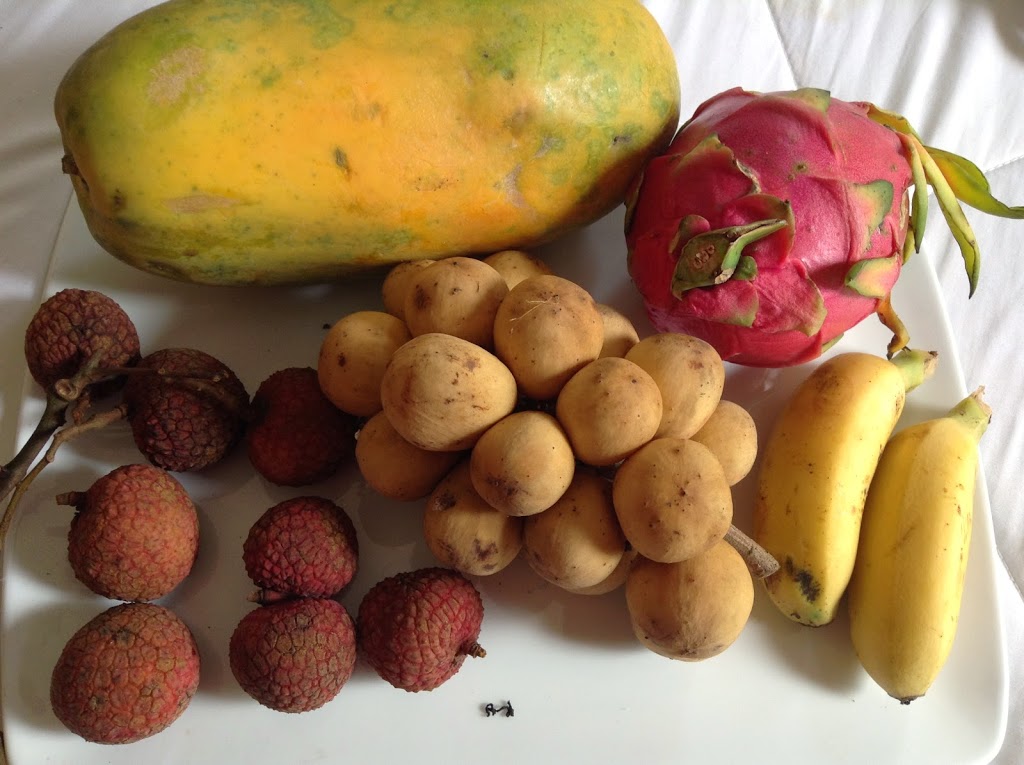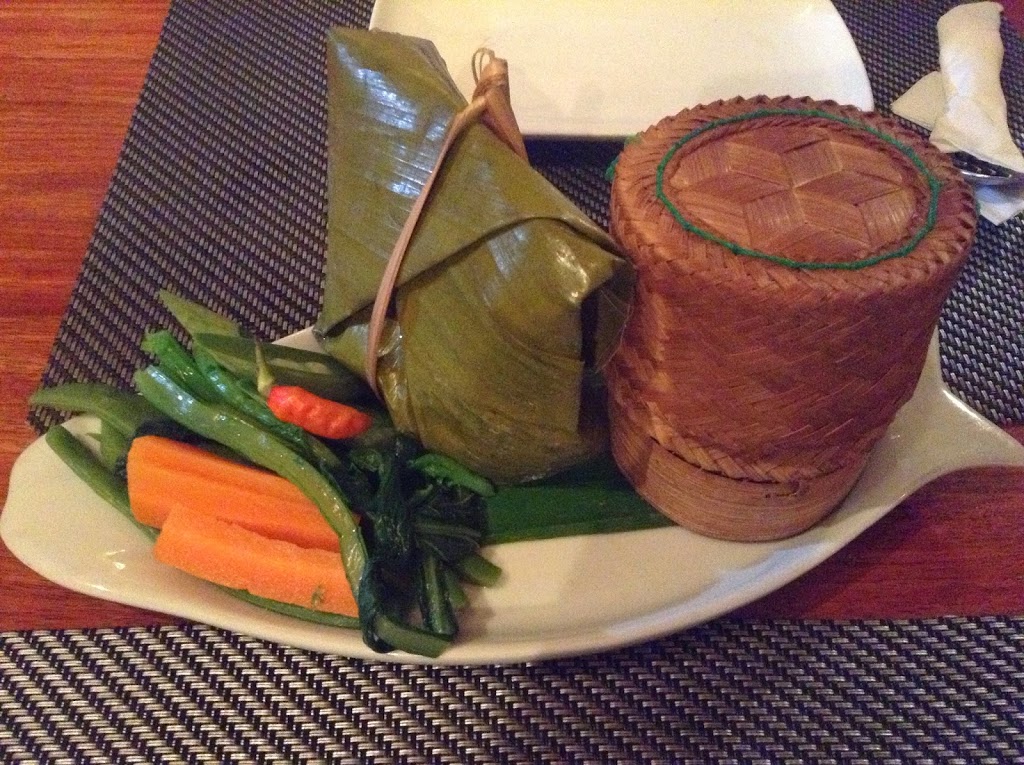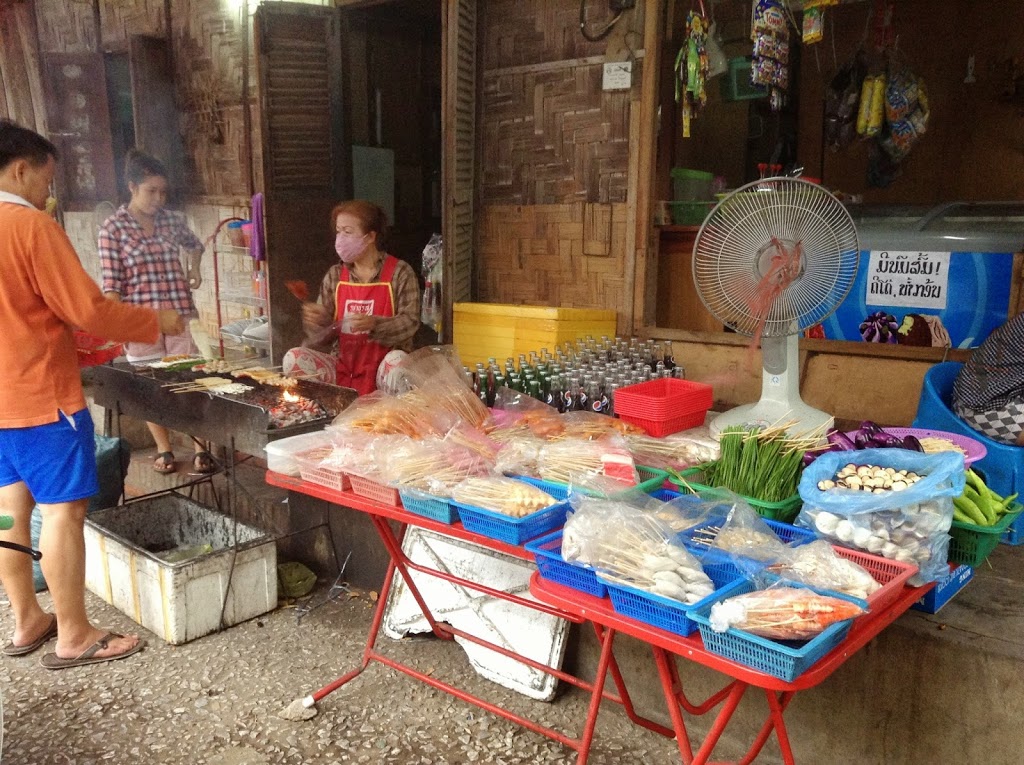 |
| Lemongrass plant with stuffing of chicken and vegetables, fried and served with a sauce. Very original and yummy! Specialty of Tamarind restaurant. A creative twist on Laotian food. |
We have never eaten Laotian food before and have never seen a Laotian restaurant anywhere in our travels or places we have lived. Have any of you ever eaten Laotian food? It is definitely not a well known cuisine in the way that other Asian cuisines are.
 |
| Grilled whole fish, chicken, meat all grilled on the stick. The key is to get here early when everything is first cooked. |
 |
| Crispy grilled fish: perfectly simple, and delicious served with a tangy sweet and sour dipping sauce. Eaten at a small table under the trees. |
There are some similarities between Laos and Thai food, although Thai food is typically spicier and Laotian food has more strength of flavor which comes from herbs and roots. Actually, Laotian food influenced Thai food, as a section of North Eastern Thailand, (Issan) used to be part of Laos.
In Luang Prabang, the river provides for fish as a central component to many meals.The fish is grilled whole, with long lemongrass sticks cooked in it’s center, or steamed in a banana leaf, reminiscent of a tamale. Or in a fish soup. Or on skewers on the grill, as pressed fish. We had a particularly delicious grilled crispy fish at a small restaurant with 2 tables outside under the trees.
 |
| Banana leaf parcels have a variety of different fillings. Fish, sticky rice, eggplant and mushroom, a Laotian version of a super light tamale. |
Then there is river weed ~ crispy dark green squares, similar to nori, but flash fried with garlic and sesame seeds. Pretty tasty with the texture of nori but a different taste.
 |
| River weed: crispy, topped with sesame seeds and peanuts and scallions. |
Sticky rice is the staple food in Laos. It takes hours to cook and can be made with black rice or white rice depending on the meal it is being used for. (Black rice for dessert.) It is scooped out of little bamboo containers, by hand and used as a “scoop” for picking up other foods. There is something so satisfying about sticky rice!
A popular street food is food on mini skewers. A table displays a variety of choices…tofu, pressed fish, chicken, meat, eggplant, enoki mushrooms, spring onions. At 1.000 kip per skewer (11c), locals (and us of course) grab a handful of the sticks with the bites of our choice, to take to the person in charge of the grill. Minutes later the skewers are done and being dipped in yummy homemade sauces on our little table on the edge of the sidewalk.
 |
| Sliced eggplant, spring onions, whole eggplant, mild chilis and enoki mushrooms (far right) all ready for the grill. |
 |
| Grilling it up! |
Street food is not as prevalent as it is in Viet Nam or Thailand. However, after being here for a few weeks now, we have had the time to slowly discover the different specialties as well as, the locations which we like. Some are located on the Mekong river and have a great view especially at sunset, and others are at the market or in somewhat hidden corners or little shops in between the cafes.
Ah the cafes…..
The French were here many decades ago – In addition to their beautiful architecture, they left as well their touch on food. So in addition to local Laotian food, there is good French food. Joy oh joy! Excellent croissants, pain au chocolat and baguettes.
When you live a nomadic lifestyle, as opposed to going on a trip or a vacation for a few weeks, it’s always fun to find a food from a different region which transports you back to a different time and a different place. This food is typically not local, but we are not purists, in the sense that we do enjoy good food, not only local food. For example, even though Hoi An in Viet Nam had amazing food, it was still fun to have good Indian food there. We had great homemade bagels we found in Chiang Mai, Thailand. And now, we have pain au chocolat here.
 |
| Our favorite french cafe with fresh baguette and croissant. It is tempting to eat here everyday, but yes, we pace ourselves. (Somewhat.) |
Markets as always are a veritable treasure trove of tropical fruits. We are always to be found leaving the market with bags of our favorite fruit finds. Our current market favorites are papaya, langsat, (small fruit which has segments of juicy white flesh like a cross between a grapefruit and a lychee), dragon fruit and lychees.
 |
| Fruit from the market: Lychees, papaya, langsat, dragon fruit and mini bananas |
The langsat, the light brown skinned fruit in the photo above, aside from being rich in Vitamin C, contains Riboflavin, which can counter migraines, and Niacin which reduces cholesterol. It is rich in calcium and Vitamin C. In short, a delicious fruit with healing power.


Hi,
I just found your blog and want to invite you to provide a guest post on our site, Retirement And Good Living, about your traveling and green tek adventures in Central America and Asia.
We launched our retirement site at http://retirementandgoodliving.com which provides information on a variety of topics including life, travel, volunteering, health, finances, retirement locations, hobbies, part time work and much more to boomers, recent retirees and others thinking about or planning for retirement.
Currently the blog section of our site is comprised entirely of posts by guests on a variety of topics. To date nearly 200 guests from around the globe provided posts for our blog.
Please let me know if you are interested and I will forward additional information.
Thanks,
Simone Harrison
simone@retirementandgoodliving.com
Retirement And Good Living
Thank you SImone ~ we just wrote you an email. We would be delighted to write a guest post on your site.
From your description, I think it would be hard to open a Laotian restaurant in, say, Chicago, since our fresh fish and river weed would have entirely different flavors. It sounds site specific, is what I’m saying. Nice post. Love the little bamboo rice pots, and the beautiful grill girl.
Yes, you are correct Sharon about the fresh fish part. However, the river weed is packaged here and is exported to Lao expat communities around the world (in US, France, Australia …) Also many of the herbs are very specific to this region. Yes, aren’t the bamboo rice pots fun (we are tempted to hoard some, but not very practical given our nomadic lifestyle).
My, my, Peta, amazing how you stay thin with all these goodies available . Such tasty shots, like the banana leaf parcels and river weed. Why do they have to cook rice for hours???
Hugs, Charles
The many hours is unique to STICKY rice. Regular “steamed” rice requires “regular” cooking time. The 5 hours of boiling for sticky rice is what gives it that very unique feel – where each grain is soft, but they combine as a cluster that becomes crunchy. Very delicious and very different from regular rice. Glad you like the photos and thanks Charles for the nice feedback… hugs (Peta)